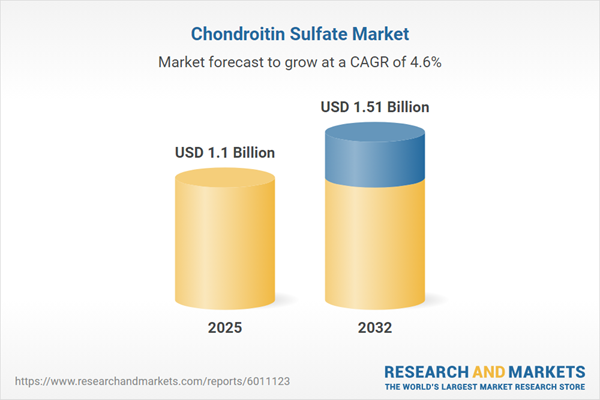Speak directly to the analyst to clarify any post sales queries you may have.
The chondroitin sulfate market is evolving rapidly, offering senior executives strategic opportunities to enhance competitiveness through improved supply chain management, digital adoption, and stronger compliance. A focus on resilience and innovation positions businesses to address current and emerging challenges efficiently.
Market Snapshot: Global Overview of the Chondroitin Sulfate Market
The global chondroitin sulfate market is exhibiting steady growth, driven by shifting demographics and ongoing advancements in extraction and processing technologies. Chondroitin sulfate remains integral to the dietary supplements, pharmaceutical, and veterinary industries, supporting applications in human and animal health. Regulatory frameworks are becoming increasingly stringent, influencing operational approaches and emphasizing the need for robust, adaptive supply chains. Organizations active in this landscape must balance innovation with compliance, while leveraging international trade opportunities to support business continuity and growth potential.
Scope & Segmentation: Comprehensive Analysis Across the Chondroitin Sulfate Value Chain
This report offers in-depth guidance designed for executive teams involved in strategic planning, R&D prioritization, and resource management. The segmentation framework enables targeted investments, risk mitigation, and informed decisions on market entry or expansion, offering clarity across the chondroitin sulfate value chain. Advanced technology integration is highlighted, particularly for traceability and quality assurance. Each segment is analyzed to support agile allocation of resources and flexible responses to evolving conditions.
- Form: Capsules, liquids, powders, and tablets address diverse clinical, consumer, and veterinary requirements, aligning with varied dosing needs.
- Source: Bovine, fish, porcine, and shark sources enable strategic focus on sustainability and animal welfare, ensuring supply flexibility.
- Manufacturing Process: Chemical synthesis, enzymatic hydrolysis, and fermentation enable scalable production and consistent product standardization, supporting quality and compliance objectives.
- Application: Areas including animal feed, pharmaceuticals, dietary supplements, cosmetics, cosmeceuticals, and animal nutrition drive sectoral growth and diversification opportunities.
- Distribution Channel: Pharmacies, specialty retailers, drug stores, and digital platforms facilitate adaptable market access strategies in both established and emerging channels.
- Key Geographic Regions: Markets in the Americas, Europe, Middle East and Africa, and Asia-Pacific each present unique regulatory requirements and competitive landscapes.
- Major Industry Participants: Leading organizations such as Koninklijke DSM N.V., Seikagaku Corporation, TRB Chemedica Ltd., Bioiberica S.A., Fatro S.p.A., Rottapharm | Madaus GmbH, Shandong Darentai Biological Technology Co., Ltd., Zhejiang Medicine Co., Ltd., Summit Nutritionals International, and TSI Group Co., LTD demonstrate sector stability and ongoing product innovation.
Adoption of digital supply chain tools across segments increases transparency, optimizes inventory, and enhances regulatory responsiveness. These strengths are crucial for sustaining performance and quickly addressing evolving customer and compliance demands worldwide.
Key Takeaways for Senior Decision-Makers
- Biotechnology-driven and marine sourcing methods support compliance with modern sustainability criteria and improve traceability across the value chain.
- Advanced extraction and fermentation techniques play a decisive role in meeting quality and safety requirements for pharmaceutical and wellness products.
- Expanding into nutraceutical and cosmeceutical markets diversifies revenue streams, helping reduce exposure to demand fluctuations in core verticals.
- Integrating digital platforms with traditional distribution broadens customer reach and increases agility in response to evolving B2B and retail procurement preferences.
- Collaboration across different industry stakeholders is fostering innovation and assisting companies in adapting to shifting standards and buyer expectations.
- Regionally tailored product offerings and operational models enhance compliance, sustain relevance, and underpin successful international expansion efforts.
Tariff Impact: U.S. Supply Chain and Pricing
Recently implemented U.S. tariffs have increased import costs for select chondroitin sulfate raw materials. In response, many organizations are intensifying their focus on domestic and marine-based sourcing, reducing dependency on foreign suppliers and building overall supply chain resilience to meet complex global market requirements.
Methodology & Data Sources
This report is based on direct engagement with industry stakeholders, combined with secondary research. Analytical methods such as SWOT analysis and Porter’s Five Forces were applied to ensure insights address the specific decision-making needs of senior leaders within the chondroitin sulfate sector.
Why This Report Matters
- Enables effective compliance with evolving global regulations and facilitates quick sourcing adaptation as industry conditions change.
- Provides executive teams with targeted insights to navigate segmented global markets, supporting robust strategic planning and operational flexibility.
- Delivers well-researched intelligence to help leadership adapt confidently to sector changes, promoting organizational stability and continuity.
Conclusion
Senior leaders can leverage this report for focused growth, operational agility, and informed responses to ongoing shifts in the chondroitin sulfate market environment.
Additional Product Information:
- Purchase of this report includes 1 year online access with quarterly updates.
- This report can be updated on request. Please contact our Customer Experience team using the Ask a Question widget on our website.
Table of Contents
3. Executive Summary
4. Market Overview
7. Cumulative Impact of Artificial Intelligence 2025
Companies Mentioned
The companies profiled in this Chondroitin Sulfate market report include:- Koninklijke DSM N.V.
- Seikagaku Corporation
- TRB Chemedica Ltd.
- Bioiberica S.A.
- Fatro S.p.A.
- Rottapharm | Madaus GmbH
- Shandong Darentai Biological Technology Co., Ltd.
- Zhejiang Medicine Co., Ltd.
- Summit Nutritionals International
- TSI Group Co., LTD
Table Information
| Report Attribute | Details |
|---|---|
| No. of Pages | 189 |
| Published | October 2025 |
| Forecast Period | 2025 - 2032 |
| Estimated Market Value ( USD | $ 1.1 Billion |
| Forecasted Market Value ( USD | $ 1.51 Billion |
| Compound Annual Growth Rate | 4.6% |
| Regions Covered | Global |
| No. of Companies Mentioned | 11 |









